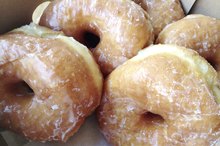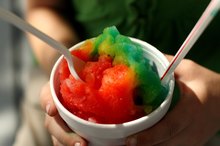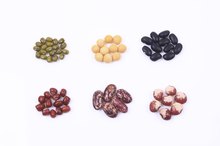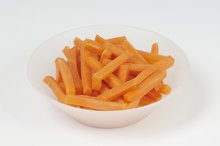What does fact checked mean?
At Healthfully, we strive to deliver objective content that is accurate and up-to-date. Our team periodically reviews articles in order to ensure content quality. The sources cited below consist of evidence from peer-reviewed journals, prominent medical organizations, academic associations, and government data.
- U.S. National Center for Complementary and Alternative Medicine; Herbs at a Glance - Licorice Root; 2010
- MedlinePlus: Licorice -- Glycyrrhiza glabra L. -- and DGL -- Deglycyrrhizinated Licorice
The information contained on this site is for informational purposes only, and should not be used as a substitute for the advice of a professional health care provider. Please check with the appropriate physician regarding health questions and concerns. Although we strive to deliver accurate and up-to-date information, no guarantee to that effect is made.
Does Eating Black Licorice Raise Your Blood Sugar?
Black licorice root is a medicinal plant that has no calories, or sugar, and does not cause elevation in blood sugar. Black licorice candy, on the other hand, is high in sugar or corn syrup and will quickly raise your blood sugar levels. Always ask your health-care provider if you are concerned about elevated blood sugar.
Licorice Root
Black licorice root is an herb used to soothe peptic ulcers, sore throat and bronchitis. It has no known ill-health effects on blood sugar levels. Peeled licorice root is available in dried or powdered form. It is commonly brewed as a tea or taken as a pill. According to the U.S. National Center for Complementary and Alternative Medicine, taken in large doses, licorice root is suspected to cause water retention and to raise blood pressure 1.
- Black licorice root is an herb used to soothe peptic ulcers, sore throat and bronchitis.
Black Licorice Candy
Calories in Jolly Ranchers
Learn More
Black licorice candy is a sweet, chewy candy sold in sticks or small pieces. Black licorice candy is high in sugar. Ten small pieces of black licorice contain 150 calories including 18 grams of sugar or the equivalent of about 5 teaspoons of sugar. This amount of sugar is enough to elevate your blood sugar level; in fact, the glycemic index, or GI, score for black licorice is 78, making it a high-GI food.
- Black licorice candy is a sweet, chewy candy sold in sticks or small pieces.
- Ten small pieces of black licorice contain 150 calories including 18 grams of sugar or the equivalent of about 5 teaspoons of sugar.
Glycemic Index, Explained
The glycemic index is a tool that diabetics and people watching their blood sugar level use to predict how much a certain food will elevate their blood sugar. It is very important that people with diabetes do not undergo extreme rises and falls in their blood sugar because this can make them very sick. The glycemic index score represents how much a certain food, like a serving of black licorice, raises blood sugar in comparison to 50 grams of pure glucose or refined white bread. Foods with a GI score of 75 or higher are considered high-GI, and should be eaten in moderation or consumed with high-fat or high-protein foods to slow digestion and absorption of the sugar.
- The glycemic index is a tool that diabetics and people watching their blood sugar level use to predict how much a certain food will elevate their blood sugar.
- Foods with a GI score of 75 or higher are considered high-GI, and should be eaten in moderation or consumed with high-fat or high-protein foods to slow digestion and absorption of the sugar.
Considerations
What Happens to Sugar Levels in the Blood While Fasting?
Learn More
Some manufacturers make sugar-free varieties of black licorice candy, which do not elevate blood sugar levels. However, consuming too much sugar-free food can create a preference for very sweet foods and also move people to over-eat carbohydrates. Black licorice candy is a once-in-awhile treat, with some medicinal benefits derived from the licorice extract. Check the ingredient label to determine whether natural licorice extract is used, versus artificial anise flavoring.
- Some manufacturers make sugar-free varieties of black licorice candy, which do not elevate blood sugar levels.
Related Articles
References
- U.S. National Center for Complementary and Alternative Medicine; Herbs at a Glance - Licorice Root; 2010
- Mendosa.com: Revised International Table of Glycemic Index (GI) and Glycemic Load (GL) Values—2008
- NIH National Center for Complementary and Integrative Health. Licorice root. Updated December 1, 2016.
- Raveendra KR, Jayachandra, Srinivasa V, et al. An extract of glycyrrhiza glabra (GutGard)alleviates symptoms of functional dyspepsia: a randomized, double-blind, placebo-controlled study. Evidence-Based Complementary and Alternative Medicine. 2012;2012:1-9. doi:10.1155/2012/216970
- Messier C, Epifano F, Genovese S, Grenier D. Licorice and its potential beneficial effects in common oro-dental diseases. Oral Dis. 2012;18(1):32-39. doi:10.1111/j.1601-0825.2011.01842.x
- Shi Q, Hou Y, Yang Y, Bai G. Protective effects of glycyrrhizin against β2-adrenergic receptor agonist-induced receptor internalization and cell apoptosis. Biol. Pharm. Bull. 2011;34(5):609-617. doi:10.1248/bpb.34.609
- Tsao S, Yin M. Antioxidative and antiinflammatory activities of asiatic acid, glycyrrhizic Acid, and oleanolic acid in human bronchial epithelial cells. J. Agric. Food Chem. 2015;63(12):3196-3204.
- Zhao H, Zhang X, Chen X, et al. Isoliquiritigenin, a flavonoid from licorice, blocks M2 macrophage polarization in colitis-associated tumorigenesis through downregulating PGE2 and IL-6. Toxicology and Applied Pharmacology. 2014;279(3):311-321. doi:10.1016/j.taap.2014.07.001
- Nahidi F, Zare E, Mojab F, Alavi-Majd H. Effects of licorice on relief and recurrence of menopausal hot flashes. Iranian Journal of Pharmaceutical Research: IJPR. 2012;11(2):541-8.
- Hajiaghamohammadi AA, Zargar A, Oveisi S, Samimi R, Reisian S. To evaluate of the effect of adding licorice to the standard treatment regimen of helicobacter pylori. The Brazilian Journal of Infectious Diseases. 2016;20(6):534-538. doi: 10.1016/j.bjid.2016.07.015
- Irani M, Sarmadi M, Bernard F, Ebrahimi Pour GH, Shaker Bazarnov H. Leaves antimicrobial activity of Glycyrrhiza glabra L. Iranian Journal of Pharmaceutical Research: IJPR. 2010;9(4):425-8.
- Penn State Hershey Milton S. Hershey Medical Center. Licorice.
- Omar HR, Komarova I, El-Ghonemi M, et al. Licorice abuse: time to send a warning message. Therapeutic Advances in Endocrinology. 2012;3(4):125-138. doi:10.1177/2042018812454322
- Räikkönen K, Martikainen S, Pesonen A, et al. Maternal licorice consumption during pregnancy and pubertal, cognitive, and psychiatric outcomes in children. Am J Epidemiol. 2017;185(5):317-328. doi:10.1093/aje/kww172
- Consumer Reports. Food and drug interactions you need to know about. Updated November 4, 2018.
- Winchester Hospital. Library. Updated April 11, 2011.
- Consumer Reports. How to choose supplements wisely. Updated October 30, 2019.
- FDA. Black licorice: Trick or treat? Updated November 6, 2017.
Writer Bio
Janelle Commins started writing professionally in 2007. She has written for the "UCLA Total Wellness" magazine on nutrition and fitness topics that are of interest to young adults. Her work has also appeared in various online publications. She holds a Bachelor of Science in nutrition science from University of California, Davis, and a Master of Science in public health from University of California, Los Angeles.









